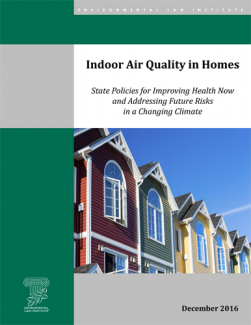
Communities throughout the U.S. are experiencing a variety of conditions associated with climate change – heat waves, droughts, intense storms and flooding, and more severe wildfires. In 2011, the Institute of Medicine issued a comprehensive report on the wide ranging impacts of climate change on indoor air quality, with a focus on five topic areas: indoor air pollutants; indoor dampness and mold; infectious agents, insects, and arthropods found indoors; indoor temperature and humidity; and building weatherization, ventilation, and energy use. The report concludes, “the available research indicates that climate change may make existing indoor environmental problems worse and introduce new problems...”
This report focuses on three IAQ-related areas that are affected by climate change: (1) dampness and mold; (2) energy efficiency upgrades; and (3) wildfire smoke. By implementing stronger policies in these areas, states can reap considerable health and economic benefits now, while also creating buildings that are more resilient to changing conditions in the future.
For each issue, the report describes existing state laws, regulations, and other policies and highlights considerations for developing stronger policies and programs.
Dampness and Mold. Extreme weather events and local changes in temperature and humidity can create indoor dampness and mold problems. There are well-established practices for controlling moisture in building design, construction, and management, and there are numerous technical guidance documents explaining these practices. This chapter of the report discusses two state policy strategies for preventing and fixing mold and dampness problems: regulating mold service providers, and regulating dampness and mold conditions in rental housing through housing codes and landlord-tenant laws. Download the Dampness and Mold chapter.
Energy Efficiency and IAQ. There is broad recognition that it is possible to achieve both energy efficiency and IAQ goals in a home energy retrofit project. By integrating IAQ into home energy retrofit policies and programs, states and other jurisdictions avoid creating or worsening IAQ problems and can also take advantage of a key opportunity to improve IAQ in the home. This chapter discusses how the federal Weatherization Assistance Program (WAP) for low-income households addresses ventilation and other IAQ issues and notes examples of state policies that integrate IAQ into WAP and other state energy efficiency programs. Download the Energy Efficiency and IAQ chapter.
Wildfire Smoke. At the time this report was published in 2016, wildfires had been increasing dramatically in size and duration and exposure to wildfire smoke was already a serious public health threat. Those trends have continued in the years since publication. In 2024, ELI updated our research and published a new report on state policies for reducing indoor exposure to wildfire smoke through air filtration and other measures. Download ELI’s 2024 report, Wildfire Smoke: State Policies for Reducing Indoor Exposure.
Explore other materials from ELI’s Indoor Environments Program.
© Environmental Law Institute®